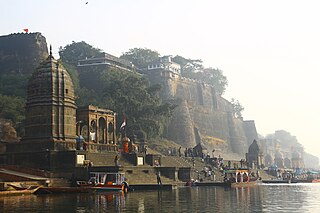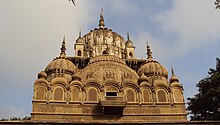
Indore is the largest and most populous city in the Indian state of Madhya Pradesh. It is the commercial hub of Madhya Pradesh. It is consistently ranked as the cleanest city in India. It serves as the headquarters of both the Indore District and the Indore Division. It is also considered the state education hub and houses campuses of both the Indian Institute of Technology and the Indian Institute of Management. Located on the southern edge of Malwa Plateau, at an average altitude of 553 metres (1,814 ft) above sea level, it has the highest elevation among major cities of Central India. The city is 190 km (120 mi) west of the state capital of Bhopal. It is 57 km (35 mi) from Ujjain and 35 km (20 mi) from Dewas. Indore had a census-estimated 2011 population of 1,994,397 and 3,570,295. The city is distributed over a land area of just 530 square kilometres (200 sq mi), making Indore the most densely populated major city in the central province.

The Central India Agency was created in 1854, by amalgamating the Western Malwa Agency with other smaller political offices which formerly reported to the Governor-General of India. The agency was overseen by a political agent who maintained relations of the Government of India with the princely states and influence over them on behalf of the Governor-General. The headquarters of the agent were at Indore.

Dewas is a city in the Malwa region of the Indian state of Madhya Pradesh. The municipality was formerly the seat of two 15-Gun Salute state princely states during the British Raj, Dewas Junior state and Dewas Senior state, ruled by the Pawar clan of the Marathas. The city is the administrative capital of Dewas district. Dewas is an industrialised city and houses a government bank note press.

Datia, also known as Daityavakra is the district headquarter of the Datia District in north central Madhya Pradesh, a state of Central India. It is an ancient town, mentioned in the Mahabharata ruled by King Dantavakra. The city is 71 km from Gwalior, 325 km south of New Delhi and 344 km north of Bhopal. About 18 km from Datia is Sonagiri, a sacred Jaina hill. Datia is also about 52 km from Orchha. The nearest airport is at Gwalior. It was formerly the seat of the eponymous princely state in the British Raj. Datia is situated near Gwalior and on the border with Uttar Pradesh.

Maheshwar is a town, near Khargone city in Khargone district of Madhya Pradesh state, in central India. It is located on State Highway-38 ,13.5 km east of National Highway 3 and 91 km from Indore, the commercial capital of the state. The Town lies on the north bank of the Narmada River. It was the kingdom of Chaktavartin Samrat Sahastraarjun, Kartavirya Arjuna a Heheya king. Lately, after many years, it was the capital of the Malwa during the Maratha Holkar reign till 6 January 1818, when the capital was shifted to Indore by Malhar Rao Holkar III.

The Holkars were the ruling house of the Indore State of the Maratha Confederacy, and earlier held the rank of Subahdar under Peshwa Baji Rao I. When the Maratha Confederacy began to weaken due to internal clashes, the Holkars declared themselves the rulers of Indore in Central India, existing as an autonomous member of the Maratha Confederacy until 1818. Later, their kingdom became a princely state under the British protection.

Chhatri are semi-open, elevated, dome-shaped pavilions used as an element in Indo-Islamic architecture and Indian architecture. They are most commonly square, octagonal, and round.

Ahilyabai Holkar, also spelled Ahalya Bai, was the Rajamata and later the ruling queen of Indore within the Maratha Confederacy. She established Maheshwar as the seat of the Holkar Dynasty. A beloved figure of Indian history, she is renowned for good governance, social welfare, and humanitarian work along with religious, educational, and cultural advancements. She contributed to the growth of Indian architecture through the commission of various temples, Ghats, and Dharmshalas. Ahilyabai's Matha, or charitable endowments, spread across India. Remembered as a Sadhvi, or holy woman,
Kanad is a town and a nagar parishad in Agar Malwa district in the Indian state of Madhya Pradesh. It comes under Kanad Parishad. It belongs to Ujjain Division. It is situated along the Agar–Sarangpur SH-41 highway. It is located 18 km (11 mi) towards east from the district headquarters of Agar Malwa, 83 km (52 mi) from Ujjain, 186 km (116 mi) from the state capital of Bhopal.

Datia District is one of important district in Gwalior Division in the Indian state of Madhya Pradesh. The town of Datia is its district headquarters.

Bhind District is a district in the Chambal division of the Indian state of Madhya Pradesh.

Kumher is a historical town, the initial name of this town was Kuber. It is located in Deeg District of Rajasthan, India.

Malhar Rao Holkar was a noble subedar of the Maratha Empire, in present-day India. He was one of the early officers along with Ranoji Scindia to help spread the Maratha rule to northern states and was given the estate of Indore to rule by the [chhatrapati's Pradhan, during the reign of the Maratha emperor Shahu I. He was founder of the Holkar dynasty that ruled Malwa.

The Bundelkhand Agency was a political agency of the British Raj, managing the relations of the British government with the protected princely states of the Bundelkhand region.

Gwalior Residency was a political office in the British Indian Empire, which existed from 1782 until the British withdrawal from India in 1947.

The Gwalior State was a state within the Maratha Confederacy located in Central India. It was ruled by the House of Scindia, a Hindu Maratha dynasty. Following the dissolution of the Confederacy, it became part of the Central India Agency of the Indian Empire under British protection.
Betma is a town and a nagar panchayat in Indore district in the state of Madhya Pradesh, India.

Rao Nandlal Chaudhary was a Gaur Brahmin and the chief of the Zamindars of Kampel, near Indore. Under the suzerainty of the Mughals, he controlled Kampel and some of its surrounding area including Indore. He accepted the suzerainty of the Marathas, after the Nizam acceded to the Peshwa's demands in 1724.
Khanderao Holkar was the only son of Malhar Rao Holkar, the founder of the Holkar dynasty of Indore, and Gautama Bai. He was the husband of Ahilyabai Holkar. He served as a Maratha Sardar and fought several campaigns on behest of the Maratha empire.

The Krishnapura Chhatris, also known as the Krishna Pura Chhatris are three chhatris located in Indore, Madhya Pradesh, India. The structures were built by the Holkars as cenotaphs over the spots where people of importance were cremated, leading to them also being known as the Holkar Chhatris. All three of the Chhatris are located half a kilometer from the city palace, Rajwada, which was also built by the Holkar dynasty.



















